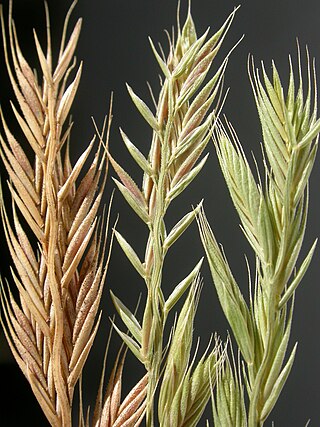
Forage is a plant material eaten by grazing livestock. Historically, the term forage has meant only plants eaten by the animals directly as pasture, crop residue, or immature cereal crops, but it is also used more loosely to include similar plants cut for fodder and carried to the animals, especially as hay or silage.

Festuca (fescue) is a genus of flowering plants belonging to the grass family Poaceae. They are evergreen or herbaceous perennial tufted grasses with a height range of 10–200 cm (4–79 in) and a cosmopolitan distribution, occurring on every continent except Antarctica. The genus is closely related to ryegrass (Lolium), and recent evidence from phylogenetic studies using DNA sequencing of plant mitochondrial DNA shows that the genus lacks monophyly. As a result, plant taxonomists have moved several species, including the forage grasses tall fescue and meadow fescue, from the genus Festuca into the genus Lolium, or alternatively into the segregate genus Schedonorus.

Festuca ovina, sheep's fescue or sheep fescue, is a species of grass. It is sometimes confused with hard fescue.

Festuca pratensis, the meadow fescue, is a perennial species of grass, which is often used as an ornamental grass in gardens, and is also an important forage crop.

Tragus, commonly called bur gras, burr grass or carrot-seed grass, is a genus of plants in the grass family. It is native to Africa, Australia, and Eurasia with several species on islands in the Atlantic, Indian, and Pacific Oceans plus one species in Argentina.

The Reserva Provincial La Payunia also known as Payún or Payén is a natural reserve located in the Malargüe Department in the southern part of Mendoza Province, Argentina, about 160 km away from Malargüe city. It was declared as nature preserve in 1988 and has an area of 4,500 km2. La Payunia is home to the many volcanic cones, being noteworthy the Payún Matrú volcano.

The pale fork-marked lemur, or western fork-marked lemur, is known from western Madagascar; south of the Fiherenana River to the region of Soalala. It is listed on CITES Appendix I.

Festuca rubra is a species of grass known by the common name red fescue, creeping red fescue or the rush-leaf fescue. It is widespread across much of the Northern Hemisphere and can tolerate many habitats and climates. It is best adapted to well-drained soils in cool, temperate climates; it prefers shadier areas and is often planted for its shade tolerance. Wild animals browse it, but it has not been important for domestic forage due to low productivity and palatability. It is also an ornamental plant for gardens.

Vulpia is a widespread genus of plants in the grass family, native to many countries around the world and naturalized in many of the nations to which it is not native. It is most common in temperate regions.

Festuca idahoensis is a species of grass known by the common names Idaho fescue and blue bunchgrass. It is native to western North America, where it is widespread and common. It can be found in many ecosystems, from shady forests to open plains grasslands.

Tussock grasses or bunch grasses are a group of grass species in the family Poaceae. They usually grow as singular plants in clumps, tufts, hummocks, or bunches, rather than forming a sod or lawn, in meadows, grasslands, and prairies. As perennial plants, most species live more than one season. Tussock grasses are often found as forage in pastures and ornamental grasses in gardens.
Tussock grassland is a form of open grassland that is dominated by tussock grasses. It is common in some temperate grasslands, savannas, and shrublands ecoregions of the Southern Hemisphere. Tussock grasslands are usually typified by low rainfall and poor soils in which few plants other than hardy tussock grasses can flourish. They are predominantly populated by tufted grasses of the genera Agrostis, Andropogon, Chionochloa, Deschampsia, Festuca, Koeleria, Pentameris and Poa. The grasslands are found in New Zealand, Australia, Argentina, temperate areas of southern and eastern Africa, and some subantarctic islands.

Chawridge Bourne is a 9.4-hectare (23-acre) biological Site of Special Scientific Interest in Berkshire, England Part of the site is a 5-hectare (12-acre) nature reserve called Chawridge Bank, which is managed by the Berkshire, Buckinghamshire and Oxfordshire Wildlife Trust.

The Patagonian grasslands (NT0804) is an ecoregion in the south of Argentina. The grasslands are home to diverse fauna, including several rare or endemic species of birds. There are few protected areas. The grasslands are threatened by overgrazing by sheep, which supply high-quality merino wool. Efforts are being made to develop sustainable grazing practices to avoid desertification.
Epichloë tembladerae is a hybrid asexual species in the fungal genus Epichloë.
Festuca argentina is a species of grass and a perennial herb, these species have a self-supporting growth form. This species is endemic to native to Argentina. This species often thrive in mountain slopes. This species was first described in 1935.
Festuca gracillima is a species of grass in the family Poaceae. This species is native to southern Argentina, and southern Chile. It is perennial and prefers temperate biomes. Festuca gracillima was first described in 1847.
Festuca monticola is a species of grass in the family Poaceae. It is native to South Chile and South Argentina. It is perennial and grows in temperate biomes. This species was first described in 1873 by Rodolfo Amando Philippi. No subspecies are listed in the Catalog of Life.












